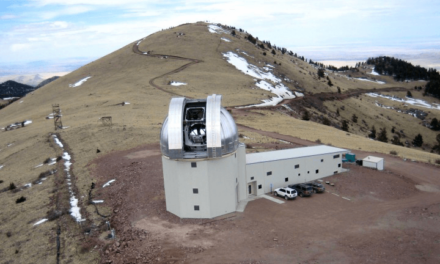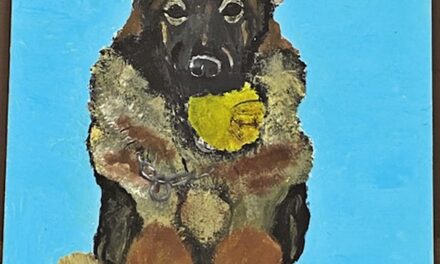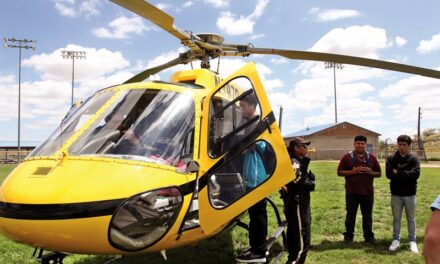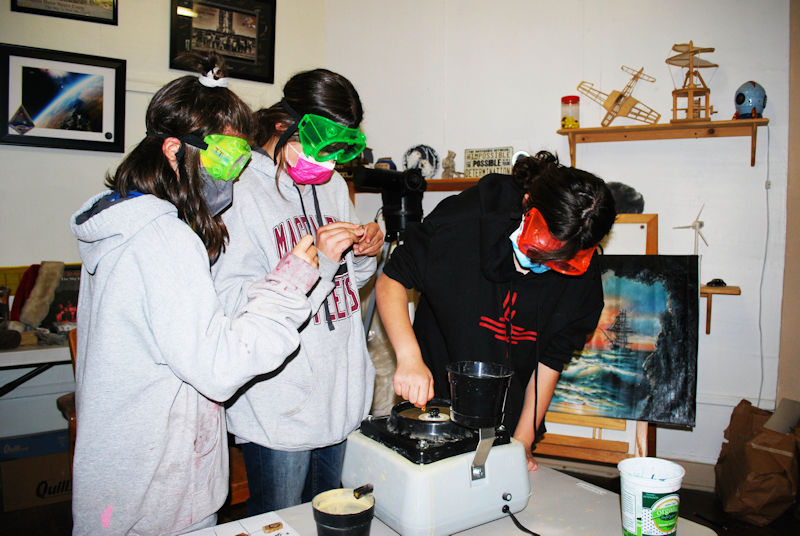
Science Cafe members Chloe, Sophia and Alivia Dorn develop their lapidary skills with a stone grinder. After grinding into shape, the rock goes into a polisher.
Photos submitted by Jim Sauer
Even during the novel coronavirus pandemic, the Kids’ Science Cafe in Magdalena continues to find creative ways to introduce science and scientific procedures to area youngsters. Located in a former church building that once housed the Senior Center in Magdalena, the Kids’ Science Cafe, a nonprofit Friday science program, marked its second anniversary in October.
The way retired middle school science teacher Jim Sauer describes it, the Kids Science Cafe is “an education program utilizing project-based discovery, exploration and experiential learning modalities of instruction. And have fun doing it.”
Sauer spearheaded the initiative to found the STEM-oriented activity center, and with an arrangement with the Village of Magdalena, which owns the building, the project – with ample support from parents and volunteers – was able to get off the ground in October 2019.
Science-oriented activities and experiments are conducted on Fridays and some weekends.
Sauer said with the emergence of the COVID-19 pandemic, participation hovered around 15-20 kids, depending on the day.
“Then COVID hit and we went down to three or five,” Sauer said. “At one point it pretty much set us all the way down for three months.”
The Friday program runs the gamut of scientific experiments, including chemistry, engineering, aeronautics, electrical engineering, robotics and computer coding.
“After COVID hit we were doing a lot of activities there in the Friday afternoon time thing, from one until five. We’re doing very, very well even with the smaller numbers of three to five to seven, and then we got closed down to where we couldn’t meet at all,” he said. “And then we opened up again and, boy, the numbers went from 3-5 to 17-25, depending on the day.”
He said that last Friday, 13 kids showed up but the average has been 17 participants for the past month.
“Friday it was geology … polishing rock, lapidary science, and ‘let’s start thinking about Christmas gifts,’” he said. “We got some stone from Dean and some templates from Dean, different shapes and stuff. We have our own polisher now, so the kids can grind down and polish a rock.”
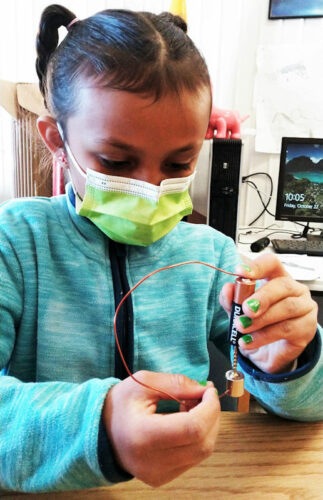
An exercise in electrical engineering involves making a simple electric motor with a copper wire, a magnet and a battery.
Masks are worn the entire time.
“We have our washing stations and we take the temperatures and oxygen of every kid,” he said. “So the kids are learning medical science at the same time as well. They’re learning about the health that they need to maintain with COVID, the concerns they need to maintain.”
In the two years, Sauer has also seen a shift in participants.
“I had some fifth graders and some sixth graders who were always participating, never missing a single day, and now some of those have gone into athletics. And that’s completely understandable,” he said. “Those kids have left, but at the same time, I’ve got new kids coming up. And frankly, I haven’t got the foggiest idea where they hail from.”
At present, a typical Friday sees a six-hour day divided into two distinct sessions.
“From 10 o’clock in the morning until 12 we usually have a lesson on process and procedure, and once they have the basic process down they can do what I’ve got everything I’ve scheduled,” Sauer said. “And then from 12 until two I’ve got coding in two groups. We’ve got Ivy (Stover) over at the library. She can handle eight people on computers and then three people on tablets. What we’re doing is we’re teaching them coding through an MIT program.”
Sauer, a retired U.S. Army helicopter pilot, has also added flying lessons – via computer – to the program.
“I’ve given some kids pilot lessons on a professional-grade flight simulator,” he said. “They’re learning to stay inside a traffic pattern, take off from a runway, and land on a runway without breaking the airplane.
“Right now, they’re learning to make a rectangular traffic pattern staying plus-or-minus five knots of an indicated airspeed and plus-or-minus 100 feet of an assigned altitude,” Sauer said. “When they do that, I give them a set of wings.”
The next objective is to virtually fly from Albuquerque International Sunport to Double Eagle Airport – navigating on a map – and land and return.
“When they do that, they get another set of wings,” he said.
Recently added is an art teacher, Judy Richardson, who introduces the kids to art projects ranging from sketching to building to sculpture.
“Embracing pretty much all of the arts,” Sauer said.
Also envisioned in 2019 was a Teen Science Cafe, held on Thursday evenings. That program is essentially overseen by the teens themselves and thrived through the first year.
“But another thing that happened back in 2020, we lost our Thursday night Teen Science Cafe,” Sauer said. “Two of the kids transferred to Santa Fe and three of the kids graduated and took off to college.”
Other members just stopped coming.
“And then some new teens, a whole new collection, by and large, started coming around and asking about it, and so we stirred that back up again,” he said. “We’ve been meeting for about the past month, and the kids are having a lot of fun.”
A new project for the burgeoning Teen Cafe scientists is doing water analysis.
“(New Mexico) Tech reached out to us and said do you have any teens who want to do water analysis,” Sauer said. “My kids were hot on it. Through a Ted Turner grant, we picked up a water quality test kit. They’re going to use electronic sensing equipment to test things like pH, hardness. We’ll look at phosphates, nitrates in the water. We’ll look at oxygen content, CO2 content.”
The teens will learn, step-by-step, how to do each one of the nine water quality tests.
“Two weeks ago I picked up a couple of Forest Service maps, and we had two groups sit down and start identifying water sources, looking at wells and springs,” Sauer said. “And we’ll add some rivers in there, like Rio Salado, which normally runs all year round. We’ll get a water quality test out of that.”
Sauer said the stand-alone observatory dedicated to the late astronomer Dan Klinglesmith has yet to be completed.

